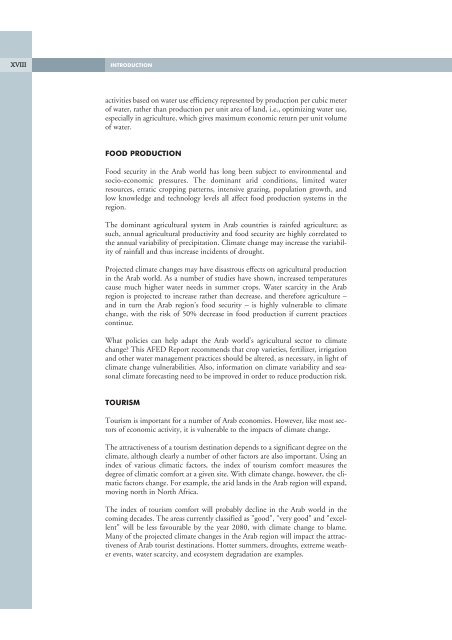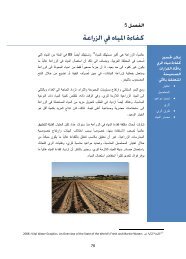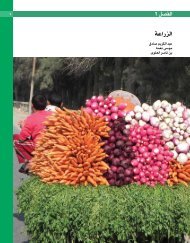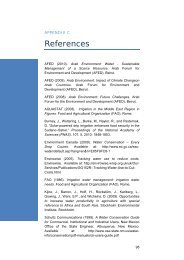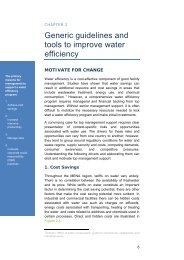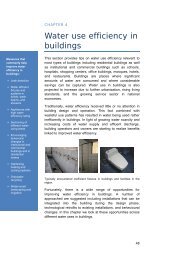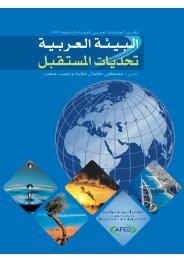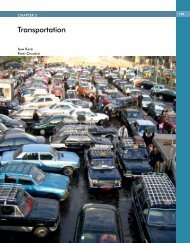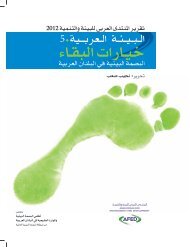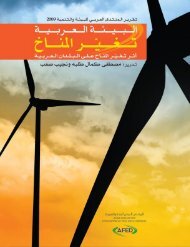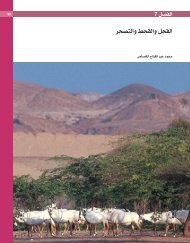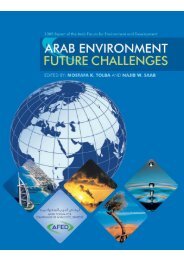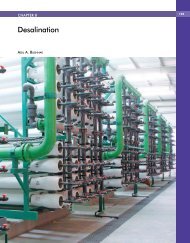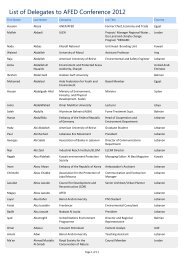Impact of Climate Change on Arab Countries - (IPCC) - Working ...
Impact of Climate Change on Arab Countries - (IPCC) - Working ...
Impact of Climate Change on Arab Countries - (IPCC) - Working ...
You also want an ePaper? Increase the reach of your titles
YUMPU automatically turns print PDFs into web optimized ePapers that Google loves.
XVIII<br />
INTRODUCTION<br />
activities based <strong>on</strong> water use efficiency represented by producti<strong>on</strong> per cubic meter<br />
<str<strong>on</strong>g>of</str<strong>on</strong>g> water, rather than producti<strong>on</strong> per unit area <str<strong>on</strong>g>of</str<strong>on</strong>g> land, i.e., optimizing water use,<br />
especially in agriculture, which gives maximum ec<strong>on</strong>omic return per unit volume<br />
<str<strong>on</strong>g>of</str<strong>on</strong>g> water.<br />
FOOD PRODUCTION<br />
Food security in the <strong>Arab</strong> world has l<strong>on</strong>g been subject to envir<strong>on</strong>mental and<br />
socio-ec<strong>on</strong>omic pressures. The dominant arid c<strong>on</strong>diti<strong>on</strong>s, limited water<br />
resources, erratic cropping patterns, intensive grazing, populati<strong>on</strong> growth, and<br />
low knowledge and technology levels all affect food producti<strong>on</strong> systems in the<br />
regi<strong>on</strong>.<br />
The dominant agricultural system in <strong>Arab</strong> countries is rainfed agriculture; as<br />
such, annual agricultural productivity and food security are highly correlated to<br />
the annual variability <str<strong>on</strong>g>of</str<strong>on</strong>g> precipitati<strong>on</strong>. <str<strong>on</strong>g>Climate</str<strong>on</strong>g> change may increase the variability<br />
<str<strong>on</strong>g>of</str<strong>on</strong>g> rainfall and thus increase incidents <str<strong>on</strong>g>of</str<strong>on</strong>g> drought.<br />
Projected climate changes may have disastrous effects <strong>on</strong> agricultural producti<strong>on</strong><br />
in the <strong>Arab</strong> world. As a number <str<strong>on</strong>g>of</str<strong>on</strong>g> studies have shown, increased temperatures<br />
cause much higher water needs in summer crops. Water scarcity in the <strong>Arab</strong><br />
regi<strong>on</strong> is projected to increase rather than decrease, and therefore agriculture –<br />
and in turn the <strong>Arab</strong> regi<strong>on</strong>’s food security – is highly vulnerable to climate<br />
change, with the risk <str<strong>on</strong>g>of</str<strong>on</strong>g> 50% decrease in food producti<strong>on</strong> if current practices<br />
c<strong>on</strong>tinue.<br />
What policies can help adapt the <strong>Arab</strong> world’s agricultural sector to climate<br />
change This AFED Report recommends that crop varieties, fertilizer, irrigati<strong>on</strong><br />
and other water management practices should be altered, as necessary, in light <str<strong>on</strong>g>of</str<strong>on</strong>g><br />
climate change vulnerabilities. Also, informati<strong>on</strong> <strong>on</strong> climate variability and seas<strong>on</strong>al<br />
climate forecasting need to be improved in order to reduce producti<strong>on</strong> risk.<br />
TOURISM<br />
Tourism is important for a number <str<strong>on</strong>g>of</str<strong>on</strong>g> <strong>Arab</strong> ec<strong>on</strong>omies. However, like most sectors<br />
<str<strong>on</strong>g>of</str<strong>on</strong>g> ec<strong>on</strong>omic activity, it is vulnerable to the impacts <str<strong>on</strong>g>of</str<strong>on</strong>g> climate change.<br />
The attractiveness <str<strong>on</strong>g>of</str<strong>on</strong>g> a tourism destinati<strong>on</strong> depends to a significant degree <strong>on</strong> the<br />
climate, although clearly a number <str<strong>on</strong>g>of</str<strong>on</strong>g> other factors are also important. Using an<br />
index <str<strong>on</strong>g>of</str<strong>on</strong>g> various climatic factors, the index <str<strong>on</strong>g>of</str<strong>on</strong>g> tourism comfort measures the<br />
degree <str<strong>on</strong>g>of</str<strong>on</strong>g> climatic comfort at a given site. With climate change, however, the climatic<br />
factors change. For example, the arid lands in the <strong>Arab</strong> regi<strong>on</strong> will expand,<br />
moving north in North Africa.<br />
The index <str<strong>on</strong>g>of</str<strong>on</strong>g> tourism comfort will probably decline in the <strong>Arab</strong> world in the<br />
coming decades. The areas currently classified as "good", "very good" and "excellent"<br />
will be less favourable by the year 2080, with climate change to blame.<br />
Many <str<strong>on</strong>g>of</str<strong>on</strong>g> the projected climate changes in the <strong>Arab</strong> regi<strong>on</strong> will impact the attractiveness<br />
<str<strong>on</strong>g>of</str<strong>on</strong>g> <strong>Arab</strong> tourist destinati<strong>on</strong>s. Hotter summers, droughts, extreme weather<br />
events, water scarcity, and ecosystem degradati<strong>on</strong> are examples.


